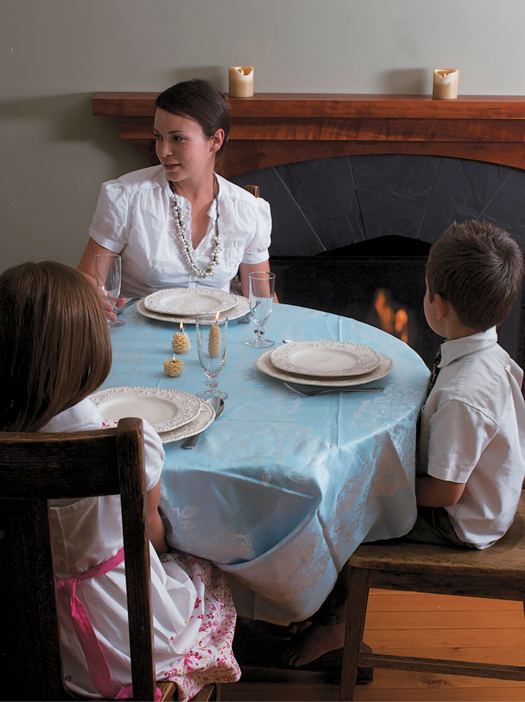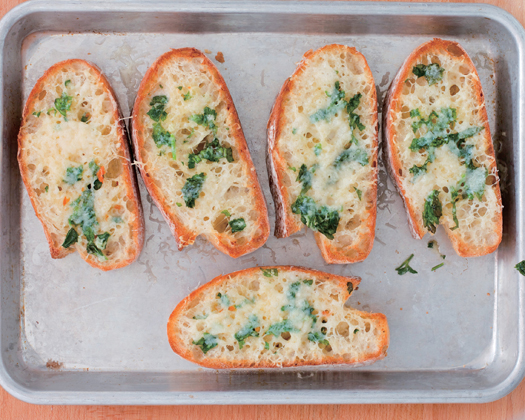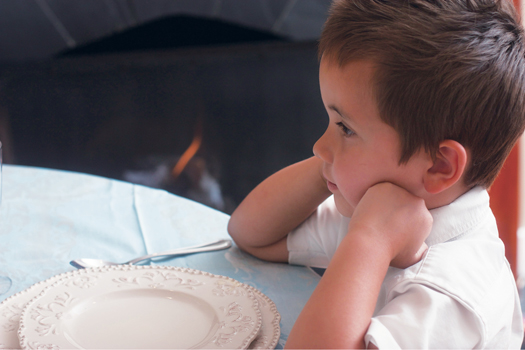RECIPES:
Homemade Fettuccini
Meatballs
Crusty Garlic Bread
Cardamom Rice Pudding
In the early days of my marriage, I wistfully mourned not having a house with a real fireplace. I had these romantic notions of a fire burning while reading books and writing letters to distant friends. My daughter would sing arias by the mantelpiece, and my sons would accompany her on the piano and cello. We would be as lovely as a Jane Austen novel. How perfect life would have been if only we had had a fireplace!
Then, recently, we had the good fortune of living in a house with one of the most beautiful fireplaces I have ever seen. Designed and built by my friend, it’s surrounded in black slate and polished cherry wood. I thought when we moved in, our fantasy of fireplace-heaven could finally begin. What I soon discovered, though, was that a real fireplace means a lot of real work: starting the fire, which takes a lot longer than one would think when the wood is cold; keeping the fire going—again, not easy when the wood is cold; and cleanup, which nearly broke my vacuum cleaner.

Still, it was nice to have real fires while we lived there. We came to understand that they were best enjoyed on special occasions such as Christmas Day or for our little family dinner party.
What I love about having a dinner party with the kids is that they appreciate all the attention to detail as much as adults do, if not more. They love the candlesticks and centerpieces, the place cards and votives. When we make a dinner party a special occasion, they enjoy dressing up and using their best manners. For our fireside supper, I made special invitations for each of the children a week ahead of time and left them on their beds. This put them in the proper frame of mind to look forward to the event and know that I would expect their best behavior.
Since we have no cook and no butler, we worked together to prepare for the meal. First, we made pasta dough, kneaded it, cut it, and let it rest while everyone helped slide the table into the living room beside the fireplace. As the sauce simmered with the meatballs, my daughter made the place cards and my sons helped with setting the table and lighting candles. While the water for the pasta came to a boil and the bread warmed up, I lit the fire. Once it was sufficiently roaring, the water was boiling and I started cooking the pasta. Within a few minutes, everything was on the table, and we enjoyed our dinner while listening to a collection of Chopin’s Nocturnes.
Nothing tastes quite as glorious as homemade pasta, so we made it for our fancy dinner, but it’s not necessary to go to all the trouble. Pasta from a box works just as well. If you don’t have a fireplace, try doing something slightly different to make the meal special, such as moving the table to the living room or lighting candles.

Homemade Fettuccini

Homemade pasta is so delicious—it can be enjoyed with a sauce or just a pat of butter and a sprinkling of Parmesan cheese. It can also be a little tricky if you’re just starting. But don’t panic. It takes a little bit of practice and patience. You may think it’s not coming together as it should, but a few passes through the machine, and it will usually work itself out. Just hang in there. Serves 8
1 cup semolina, plus more for dusting
1 cup all-purpose flour
3 eggs
1 tablespoon olive oil
Pinch of kosher salt, plus more for cooking water
1-2 tablespoons salted butter, for tossing
- In a food processor* fitted with the dough blade, pulse together semolina, all-purpose flour, eggs, olive oil, and a pinch of salt. Hold the food processor with a firm hand, and turn on the machine for 20–30 seconds to knead the dough. Wrap dough in plastic wrap and refrigerate for 30 minutes to rest.
- Divide dough in fourths. Working with each piece separately, flatten the dough and pass through a pasta roller set to the widest setting. (If the first pass results in a separated mess, don’t worry. Simply press all the little scraps into a flat rectangle with your hands, and pass through the roller again. This should make it hold together.) Fold in half, and roll through again. Repeat 3 times. Without folding, pass through again in a single layer, and repeat 3 times. Place the flat sheet of dough on a baking sheet dusted with semolina, and dust the top with more semolina. Cover with plastic wrap. Repeat the same process with the other 3 portions of dough.
- Set the roller to the next setting. Unwrap and pass each piece through in a single layer 3 times, and place on the semolina-dusted baking sheet to rest. Set the roller to the next setting, and repeat the same process again and again until the dough reaches the desired thickness. If at any time the sheets of dough get too long, cut them in half with a sharp knife.
- To make fettuccini, roll the dough until it is thin enough to see your hand through it. Spread the dough on a semolina-dusted board, and use a knife to cut it into 1⁄2-inch-wide strips, or use a fettuccini cutter. Gather the strips in a loose pile.
- Bring a large pot of water to a boil, and add 1 tablespoon of kosher salt. Working in batches, drop a handful of noodles into the water, stir, and wait for them to float to the surface. When they float for 10 seconds, remove with a slotted spoon and place in a dish. Toss with a small dab of butter to prevent sticking while you prepare the rest of the pasta. Repeat with remaining noodles. Serve with Parmesan or meatballs and marinara sauce.

Meatballs

In my college days, I worked at a walk-down deli in Provo, Utah. It was there that I learned how to make meatballs by throwing in ingredients without measuring and using tricks like baking the meatballs on parchment paper–lined baking sheets. Makes about 20 golf ball–size meatballs
2 pieces white sandwich bread
3⁄4 cup milk
1 pound lean ground beef
1 pound ground pork
1⁄2 medium yellow onion, grated
2 cloves garlic, finely minced
1 egg, lightly beaten
1 cup freshly grated Parmesan or Pecorino Romano cheese
5 fresh basil leaves, torn
1⁄4 cup chopped fresh parsley leaves
1 tablespoon tomato paste
1⁄4 teaspoon freshly ground pepper
Pinch of kosher salt, plus more for sprinkling
- Preheat oven to 350ºF. Line a large baking sheet with parchment paper.
- Pulse bread in a food processor until it becomes crumbs. Place crumbs in a small bowl and cover with milk. Let sit for 5 minutes.
- Place all ingredients, including the bread crumbs and milk, in a large bowl. Use forks or clean hands to combine gently.
- Shape mixture into meatballs, using your hands or a retractable scoop, and place on the prepared baking sheet. Sprinkle each meatball with a small pinch of kosher salt. Bake for 30 minutes, or until browned and cooked through.

Crusty Garlic Bread

When I lived in Canada, a woman used to invite my friend and me to dinner quite regularly. It was from her that I learned what a difference fresh herbs and other fresh ingredients make in cooking. This is how she made garlic bread. Serves 6
1⁄2 loaf rustic Italian bread, cut into 1⁄2-inch slices
4 tablespoons salted butter, melted
3 cloves garlic, finely minced or pushed through a garlic press
3 basil leaves, torn
2 tablespoons chopped fresh flat-leaf parsley
1⁄2 cup grated Parmesan or Pecorino Romano cheese
1⁄2 cup grated mozzarella cheese
- Preheat oven to 400ºF. Place slices of bread on a baking sheet.
- Combine melted butter, garlic, basil, parsley, and Parmesan or Pecorino Romano cheese in a small bowl. Spoon onto bread slices, and top with mozzarella.
- Toast in oven for 12–15 minutes, or until cheese is melted and the bread is toasted on the edges.

Cardamom Rice Pudding

Cardamom is one of my favorite spices. I love it in savory Indian dishes and some spiced desserts. To make this recipe even easier, place all the ingredients into a slow cooker and cook on low for 4 hours. Serves 6–8
1 vanilla bean
4 cups milk
1⁄2 cup arborio or short-grain rice
1⁄2 teaspoon ground cardamom
1⁄3 cup sugar
Pinch of salt
- With a sharp paring knife, slice the vanilla bean down the center and scrape out the seeds with the blade. Place the seeds and the scraped pod in a large high-sided skillet.
- Add the remaining ingredients to the skillet and set over medium-high heat. Bring to a boil, stirring occasionally and watching carefully that the mixture does not scorch. As soon as the mixture begins to boil, reduce the heat to a mild simmer, and cook until rice is tender and pudding thickens, about 20–25 minutes.
- Remove the empty vanilla bean pod. Spoon pudding into bowls and serve warm, or refrigerate until chilled.

